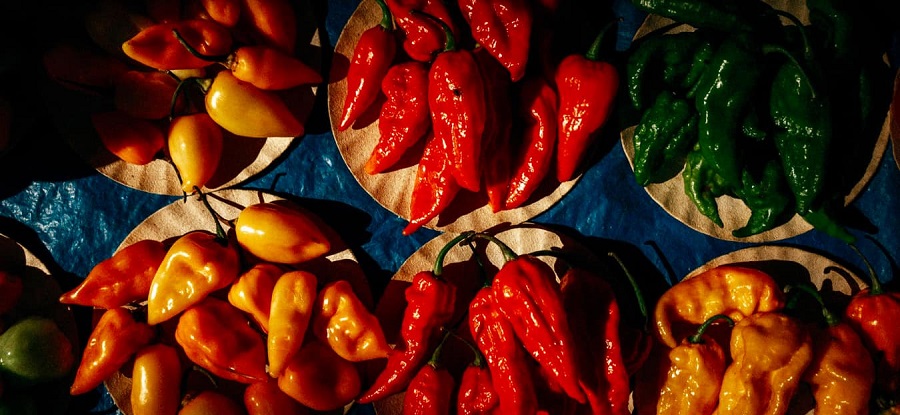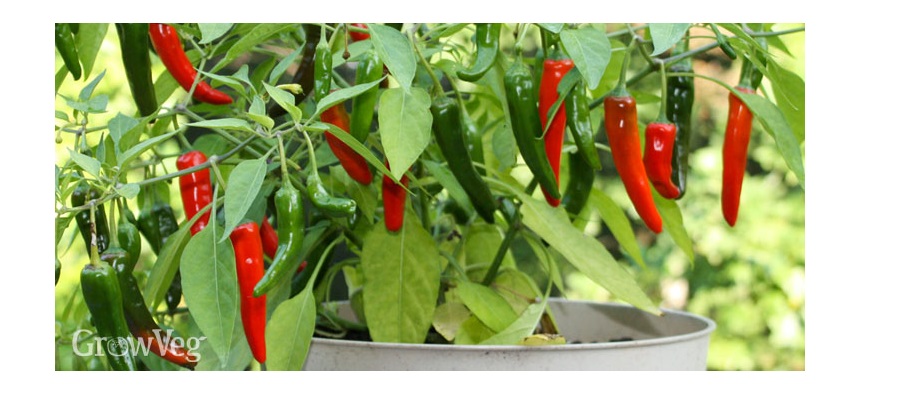What is the Scoville scale, and how is it used to measure the heat of peppers?
The Scoville scale is a measurement of the pungency or heat of chili peppers and other spicy foods. It was developed by American chemist Wilbur Scoville in 1912, and it assigns a numerical value to the amount of capsaicin, the compound responsible for the heat, present in a pepper. The scale ranges from 0 for mild peppers like bell peppers to over 2 million for the hottest peppers like the Carolina Reaper. The scale is determined through a series of taste tests in which a panel of tasters detects the heat of a pepper extract diluted in sugar water. The heat is then rated on the Scoville scale based on how much dilution is needed to make the heat undetectable.
What is the current world record holder for the hottest pepper, and how does its heat compare to other spicy peppers?
As of September 2021, the world record holder for the hottest pepper is the "Carolina Reaper," developed by Ed Currie of PuckerButt Pepper Company in South Carolina, USA. The heat level of the Carolina Reaper was officially measured at 1.641 million Scoville Heat Units (SHU) in 2017, making it significantly hotter than other super hot peppers like the Trinidad Moruga Scorpion and the Bhut Jolokia, which measure around 1.2 million SHU. However, there are some other peppers that are currently being developed that may surpass the heat level of the Carolina Reaper in the future.
Where do the world's hottest peppers originate, and what are some common varieties?
The world's hottest peppers come from various regions around the world, including South and Central America, the Caribbean, India, and the United States. Some of the most well-known varieties of the world's hottest peppers include:
- Carolina Reaper - developed in the United States
- Trinidad Moruga Scorpion - originated in Trinidad and Tobago
- Bhut Jolokia (Ghost Pepper) - originated in Northeast India
- 7 Pot Douglah - originated in Trinidad and Tobago
- Naga Viper - developed in the United Kingdom
- Scorpion Pepper - originated in Trinidad and Tobago
- 7 Pot Primo - developed in the United States
- Komodo Dragon - developed in the United States
- Chocolate Bhutlah - developed in the United States
- Dragon's Breath - developed in Wales, United Kingdom
All of these varieties are known for their extreme heat levels, with some measuring over 1 million Scoville Heat Units (SHU).
How do farmers and growers cultivate hot peppers, and what are some unique challenges associated with growing these plants?
Farmers and growers cultivate hot peppers in a similar way to other types of peppers. However, there are some unique challenges associated with growing these plants due to their high heat levels. Here are some of the common cultivation practices for hot peppers:
-
Choosing the right location: Hot peppers require a warm and sunny location with well-draining soil. They can be grown in containers or directly in the ground, but they need at least 6-8 hours of direct sunlight daily.
-
Starting seeds: Hot peppers are usually started from seeds indoors 8-10 weeks before the last frost. They require warmth to germinate, so a heating pad or other heat source may be necessary.
-
Transplanting: Once the seedlings are established, they can be transplanted to the garden or containers after the last frost. Hot peppers need plenty of space to grow, so they should be planted at least 18-24 inches apart.
-
Watering and fertilizing: Hot peppers need consistent moisture, but they don't like to be waterlogged. They should be watered deeply once a week, and fertilized every 3-4 weeks with a balanced fertilizer.
-
Pest and disease control: Hot peppers are susceptible to the same pests and diseases as other pepper plants, including aphids, spider mites, and fungal diseases. They should be monitored regularly for signs of infestation, and treated with appropriate pesticides or fungicides as needed.
-
Harvesting: Hot peppers can be harvested when they are fully mature and the desired heat level has been achieved. It's important to wear gloves when harvesting and handling hot peppers, as the capsaicin in the peppers can cause skin irritation and burning.
Some of the unique challenges associated with growing hot peppers include the need for consistent heat and moisture, as well as protection from pests and diseases. Additionally, because hot peppers are often used in small amounts in cooking, growers may need to produce a large number of plants to achieve a profitable yield.
What are some of the health benefits of consuming spicy peppers, and are these benefits linked to their heat?
Spicy peppers, including the world's hottest varieties, have been linked to a range of health benefits. Some potential benefits associated with consuming spicy peppers include:
-
Pain relief: The capsaicin in spicy peppers can act as a natural pain reliever, and has been used to treat conditions like arthritis and migraines.
-
Improved digestion: Spicy foods have been shown to stimulate the digestive system, increase gastric secretions, and improve overall digestion.
-
Lowered blood pressure: Some studies have suggested that the compounds in spicy peppers can help to lower blood pressure and improve cardiovascular health.
-
Weight loss: The heat from spicy peppers has been shown to increase metabolism and suppress appetite, potentially leading to weight loss.
It's not entirely clear whether these benefits are specifically linked to the heat of spicy peppers, or if other compounds in these foods may also play a role. Nonetheless, many people around the world enjoy incorporating spicy peppers into their diets for both their flavor and potential health benefits.
How do different cultures around the world incorporate spicy peppers into their cuisine, and what are some popular dishes that feature hot peppers?
Spicy peppers are widely used in cuisine around the world, and different cultures have their own unique ways of incorporating these fiery ingredients into their dishes. Here are a few examples:
-
Mexican cuisine: Mexican food is famous for its use of spicy peppers, particularly varieties like jalapenos, habaneros, and serranos. Popular dishes that feature hot peppers include salsa, guacamole, and chile rellenos.
-
Indian cuisine: Indian cuisine also makes use of a wide variety of spicy peppers, with dishes like vindaloo and tandoori chicken featuring particularly high levels of heat. Spicy chutneys and sauces are also common in Indian cuisine.
-
Thai cuisine: Thai food is known for its use of spicy ingredients like Thai bird's eye chilies, which are often used to add heat to dishes like curries, stir-fries, and soups.
-
Korean cuisine: Korean cuisine often incorporates gochujang, a spicy fermented chili paste, into dishes like bibimbap and kimchi.
-
African cuisine: African cuisine uses a variety of local hot peppers, with dishes like peri peri chicken and harissa featuring prominently in African cuisine.
These are just a few examples of the many different ways that cultures around the world incorporate spicy peppers into their cuisine. Whether used as a main ingredient or as a spicy accent, hot peppers can add an exciting kick of flavor to any dish.
Can eating extremely spicy peppers be dangerous, and what are some potential health risks associated with consuming these peppers in large quantities?
Consuming extremely spicy peppers can be dangerous for some people and there are potential health risks associated with consuming these peppers in large quantities. Capsaicin, the compound that gives peppers their heat, can cause irritation and inflammation in the digestive system, leading to stomach pain, nausea, and diarrhea. Some people may also experience heartburn or acid reflux after eating spicy foods.
In rare cases, consuming extremely spicy peppers can lead to more serious health problems, such as anaphylaxis, which is a severe allergic reaction. People with certain health conditions, such as ulcers, gastrointestinal disorders, or irritable bowel syndrome, may also be more sensitive to the effects of spicy foods.
Additionally, handling extremely spicy peppers can also be dangerous, as capsaicin can irritate the skin and eyes, causing pain and discomfort. It is important to handle hot peppers with care and to wash your hands thoroughly after handling them.
How do people who enjoy spicy food build up their tolerance to heat, and what strategies can they use to enjoy even hotter peppers?
People who enjoy spicy food often build up their tolerance to heat gradually over time. Some strategies for building tolerance include starting with milder peppers and gradually increasing the heat level, incorporating small amounts of hot sauce or peppers into meals, and experimenting with different types of spicy cuisine.
Other strategies for enjoying hotter peppers include drinking milk or eating dairy products to help cool the mouth, eating starchy foods like bread or rice to absorb some of the heat, and drinking lots of water to stay hydrated. It's also important to listen to your body and stop eating spicy food if it becomes uncomfortable or painful.
It's worth noting that building up tolerance to heat is a personal process, and some people may never be able to tolerate extremely spicy peppers. It's also important to remember that consuming extremely hot peppers can be dangerous for some individuals, particularly those with certain medical conditions or sensitivities. It's always best to start with milder peppers and gradually work your way up, and to consult with a healthcare professional if you have any concerns.
What is the psychological appeal of eating spicy food, and why do some people enjoy the sensation of heat and spice?
The psychological appeal of eating spicy food can vary from person to person. Some people enjoy the sensation of heat and spice because it can give them a feeling of excitement or a natural high. This is because spicy foods can cause the brain to release endorphins, which are feel-good chemicals that can produce a sense of pleasure or euphoria.
Others may enjoy spicy foods as a way to challenge themselves or prove their toughness. Some cultures even view the ability to handle spice as a sign of strength or masculinity. Additionally, some people may simply enjoy the unique flavor and complexity that spicy foods can bring to a dish.
Overall, the psychological appeal of eating spicy food can be complex and multifaceted, and may involve a combination of factors such as biology, culture, and personal preference.
Are there any new or emerging varieties of hot peppers that may soon take the title of world's hottest, and what makes these peppers unique?
There are several new and emerging varieties of hot peppers that may soon take the title of world's hottest. One such variety is the Dragon's Breath pepper, which was developed in Wales and has been tested to be potentially hotter than the current record holder, the Carolina Reaper. Another emerging variety is the Pepper X, which was developed by the same person who created the Carolina Reaper and has yet to be officially measured on the Scoville scale. These peppers are unique in their extreme heat levels, which are being constantly pushed to new limits by growers and breeders.


